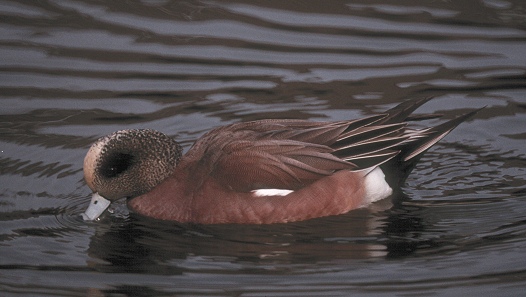|
American Wigeon Anas americana Pato Cabeciblanco,
|
 |
|
Photo: B. Hallett
|
|
American Wigeon Anas americana Pato Cabeciblanco,
|
 |
|
Photo: B. Hallett
|
|
IDENTIFICATION: A small duck with a bluish bill, a brown body, a white cap, and an iridescent, green patch behind the eye. The female (below) has a light gray head, contrasting with a light brown body. The Wigeon has a large white wing patch visible in flight. Length: 45-56 cm.; weight: 680-770 g. VOICE: A weak, abrupt whistle. Audio (M. Oberle). HABITAT: Spends the winter on brackish and freshwater marshes and ponds, especially with nearby fields or lawns where it can graze. It has also been observed floating in shallow coastal waters. HABITS: Feeds by dabbling: it grazes near the surface or dips its head in shallow water for food. It eats both aquatic plants and invertebrates, and also grazes on grasses on land. In April and May in North America, the female builds a grass nest often far from freshwater, and lines it with down feathers. She lays 7-9 eggs and does all the incubation for 23-25 days. Although pairs are monogamous, the male abandons the female soon after incubation starts. The young leave the nest within a few hours of hatching and are guided to food sources by the female. The young fledge 37-48 days after hatching. American Wigeon from as far away as Prince Edward Island in Canada have been recovered in Puerto Rico. STATUS AND CONSERVATION: This species is one of the commonest ducks in North America, but is an uncommon, migrant duck species wintering in Puerto Rico (e.g. 4 at Caño Tiburones 3 March 2001; Charca Tembladera, near Caño Tiburones, 29 November 1998 ). Population estimates in North America have been as high as 6,500,000 after a good nesting season in the 1970s, but recent levels are nowhere near that high. Wetland drainage has put pressure on breeding populations. RANGE: Breeds from central Alaska to California, the northern Great Plains and east to the Great Lakes of North America. It winters in coastal marshes from southern Alaska and coastal Nova Scotia, south through the West Indies and Mexico to northern Venezuela. TAXONOMY: ANSERIFORMES; ANATIDAE; Anatinae |
|
 |
|
|
Female - Photo: B. Hallett
|
 |
|
|
Photo: M. Oberle
|
 |
|
|
Photo: M. Oberle
|
 |
|
|
Photo: M. Oberle
|
|
References Bent, A.C. 1923. Life histories of North American wild fowl, part 1. Smithsonian Instit. U.S. National Museum Bull. 126. (Reprinted by Dover Press, NY, 1962). del Hoyo, J., A. Elliott, and J. Sargatal, eds. 1992. Handbook of Birds of the World, Vol. 1. Ostrich to ducks. Lynx Edicions, Barcelona. Ehrlich, P.R., D.S. Dobkin, and D. Wheye. 1988. The birder’s handbook: a field guide to the natural history of North American birds. Simon and Schuster/Fireside, NY. Madge, S. and H. Burn. 1988. Wildfowl: an identification guide to the ducks, geese, and swans of the world. C. Helm, London. Mowbray, T. 1999. American Wigeon (Anas americana) No. 401 in The birds of North America (A. Poole and F. Gill, eds.). The Birds of North America, Inc., Philadelphia, PA. Ortiz Rosas, P. 1981. Guía de cazador: aves de caza y especies protegidas. Depto. de Recursos Naturales, San Juan, PR. Raffaele, H.A. 1989. A guide to the birds of Puerto Rico and the Virgin Islands. Princeton. Raffaele, H.A. 1989. Una guía a las aves de Puerto Rico y las Islas Vírgenes. Publishing Resources, Inc., Santurce, PR. Raffaele, H.A., J.W. Wiley, O.H. Garrido, A.R. Keith, and J.I. Raffaele. 1998. Guide to the birds of the West Indies. Princeton. Saliva, J.E. 1994. Vieques y su fauna: Vieques wildlife manual. U.S. Fish & Wildlife Service, Boquerón, PR. Next related species in taxonomic order Previous related species in taxonomic order |
|